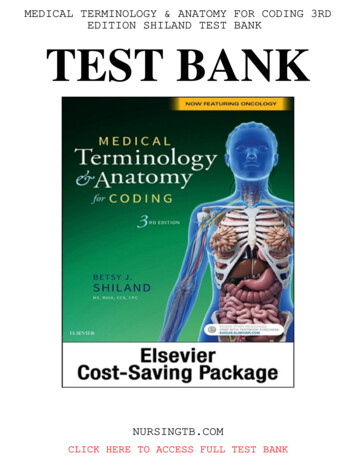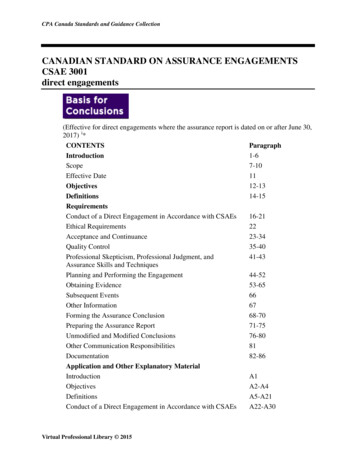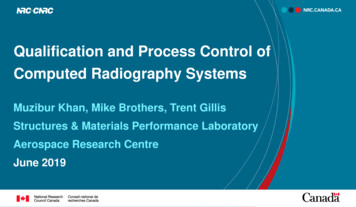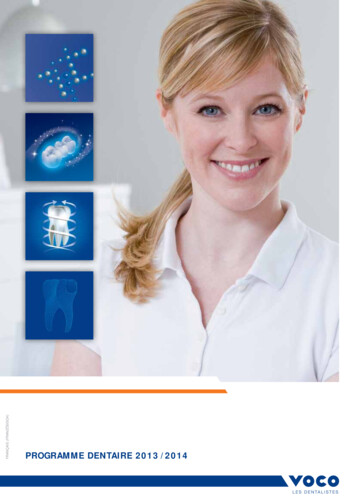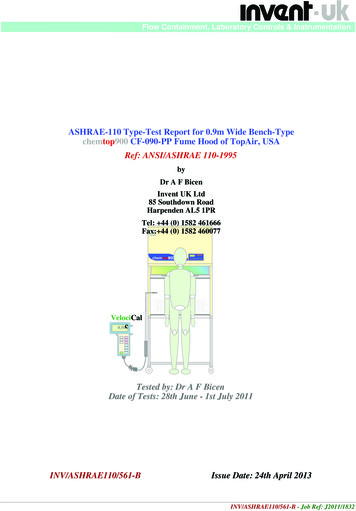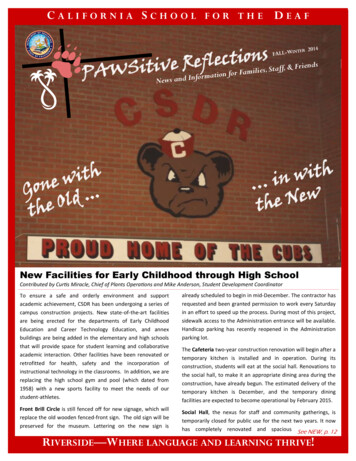
Transcription
CALIFORNIA SCHOOL FOR THE DEAFsnoitcelfeff, & FriendstaSs,ieSitive RilmaFPAWFALL-WINTER2014mation forforNews and InhtiwenoG.dlOehthtiw inweNethNew Facilities for Early Childhood through High SchoolContributed by Curtis Miracle, Chief of Plants Operations and Mike Anderson, Student Development CoordinatorTo ensure a safe and orderly environment and supportacademic achievement, CSDR has been undergoing a series ofcampus construction projects. New state-of-the-art facilitiesare being erected for the departments of Early ChildhoodEducation and Career Technology Education, and annexbuildings are being added in the elementary and high schoolsthat will provide space for student learning and collaborativeacademic interaction. Other facilities have been renovated orretrofitted for health, safety and the incorporation ofinstructional technology in the classrooms. In addition, we arereplacing the high school gym and pool (which dated from1958) with a new sports facility to meet the needs of ourstudent-athletes.Front Brill Circle is still fenced off for new signage, which willreplace the old wooden fenced-front sign. The old sign will bepreserved for the museum. Lettering on the new sign isalready scheduled to begin in mid-December. The contractor hasrequested and been granted permission to work every Saturdayin an effort to speed up the process. During most of this project,sidewalk access to the Administration entrance will be available.Handicap parking has recently reopened in the Administrationparking lot.The Cafeteria two-year construction renovation will begin after atemporary kitchen is installed and in operation. During itsconstruction, students will eat at the social hall. Renovations tothe social hall, to make it an appropriate dining area during theconstruction, have already begun. The estimated delivery of thetemporary kitchen is December, and the temporary diningfacilities are expected to become operational by February 2015.Social Hall, the nexus for staff and community gatherings, istemporarily closed for public use for the next two years. It nowhas completely renovated and spacious See NEW, p. 12RIVERSIDE—WHERE LANGUAGE AND LEARNING THRIVE!
Mission: The CaliforniaSchool for the Deaf offerscomprehensive educationaland extra-curricularprograms that preparestudents to achieve theirfull academic, social,and career potential.Superintendent:Scott Kerby, Interim( V P ) 951-824-8050Director of Instruction:Tammy Mitchell951-248-7700 Ext. 6563Director of Student Services:Jennie Machado951-248-7700 Ext. 1118Director of Residence:Ed Peigneux, Interim( V P ) 951-824-xxxxDirector of Business Services:Gloria Hernandez951-248-7700 Ext. 4193Newsletter:Published QuarterlyEmail articles and photos to:ethompson@csdr-cde.ca.govNewsletter Editor-in-Chief:Erika ThompsonCommunity Resource SpecialistCopy Editor:Brandi Davies, VolunteerArticle and Photo Contributors:Mike AndersonKaveh AngooraniMelody AyalaCA Deaf Education Resource CenterCA Speech & Hearing AssociationJeremy DavisRodney EwanAndy Granda ’ 93aj granda ‘ 92Denise HamiltonScott KerbyJenni KysellaBen McCrory ’ 97Teresa MaxwellCurtis MiracleErika ThompsonTerri VincentLaurie WaggonerStatements from the SuperintendentGood day CSDR!Recently, I was inquired in a public forum, "What is your vision at CSDR?" Some people asked,"Why is it so important for a superintendent to have a clear vision?" Simple. Because leadershipis about going somewhere. If you don't know where you are going, your leadership doesn'tmatter.Alice learned this lesson in Alice in Wonderland when she was searching for a way out ofWonderland and came to a fork in the road. "Would you tell me, please, which way I ought to gofrom here?" she asked the Cheshire Cat. "That depends a good deal on where you want togo," the cat responded. Alice replied that she really did not much care. The smiling cat told herin no uncertain terms: "Then it doesn't matter which way you go."A vision builds trust, collaboration, interdependence, motivation, and mutual responsibility forsuccess. Vision helps people make smart choices, because their decisions are being made withthe end result in mind. Vision allows us to act from a proactive stance, moving forward what wewant rather than reactively away from what we don't want. Vision empowers and excites us toreach for what we truly desire.Scott’s Vision for CSDR: A school with a nurturing environment that embraces student achievementthrough a culture of high expectations. A school with staff that are professional, who work and plan cooperatively, andalways seek what is best for students. A school that is physically and emotionally safe. A school where the work the students do is rigorous and relevant. A school where data is valued, and utilized to ensure ongoing, consistentimprovement both for the individual student and the school as a whole. A school where teachers are provided the resources, training, and support that isneeded to enable them to grow professionally and to implement the best practicesfor our students. A school where staff and parents work together, respect one another, and put thegood of the student first. A school where students learn to communicateeffectively, think critically, solve problems, beresponsible, and respect one another. A school where parents are a vital part of thestudents learning and feel welcome to participate inschool activities. A school that develops students’ abilities to set goals,refine them through teacher feedback, and achievetheir dreams.Serve with Cub Spirit and a Big Heart,Scott KerbyCSDR Interim Superintendent & Director of State SpecialSchools Division
New Staff Faces, Transfers, and New LeadershipWritten by Scott Kerby, Director of State Special Schools and Interim CSDR SuperintendentWe have some new faces serving our school with the sameheart. The new staff are working in various roles in the divisionsof Business Services, Student Services, Residential Life, andInstruction. We have a few new teachers, as well as stafftransfers and new leadership. Under the new leadership, we willcontinue to focus on a safe and orderly environment in ourschool; providing language, intervention and enrichmentactivities for our students, and engaging them in robust andrelevant after-school activities. Below are the photos of the newprincipals, teachers, teacher assistants, secretaries, and residential counselors, all of whom will be working in collaboration withparents and the community.In thisIssue:Construction, 1 & 12Superintendent, 2New Staff, 3Scott KerbyInterim Supt.Ethan Bernstein ’79Interim Asst. Supt.Tammy MitchellDirector- InstructionCommon Core, 4-6Scarlett Valencia ’97HS PrincipalGloria DanielsMS PrincipalResource Center, 7FEAST Academy, 8-9Alumni Profile, 10-11CSDR YouTube, 13School Plan, 13Alumni Success, 17Buy a Brick, 14Tyler Bayarsky ’03TA, Early ChildhoodAlexis GoldsteinTeacher, SNMia SanchezTeacher, SNScott VollmarTeacher, HSKaveh AngooraniTeacher, CTEUpcoming Events, 14Staff Tidbits:“Rode a bike to CSDRsince 2nd grade; oncebiked across America in52 days.” - Ethan B.“Been to all 50 states,and reads at least oncechapter every night.”- Scarlett V.April Getten ‘02RL Counselor, HSKara AndradeInterm. AttendantBarbara BerdyInterm. AttendantDeAndra GarciaRL Counselor, HSEvan RomanceInterm. AttendantSupt.–SuperintendentHS– High SchoolMS– Middle SchoolTA– Teacher’sAssistantSN– Special NeedsRL– Residential LifeRebecca EyrondRL Counselor, SNEverett GlennRL Counselor, HSJonathan Valencia ‘02RL Counselor, MSMartha CochranSecretaryCounseling / SpeechA warm welcome to other new CSDR staff: Luz Juarez, Custodian; Juan Najar, Custodian, Kevin Phillips ‘87, Custodian forNutrition Services; Guadalupe Rubio, Custodian; Albert Saucedo, Building Maintenance; Howard Brown, StationaryEngineer; and Rozanna Espinosa, Accountant“Once went skydiving–Phenomenal!” - Martha“To relax, I must goshopping.” - Rozanna E.“I sleep on the floor outof habit!” - Deandra G.“A Riverside native whonever cared for melons.”- Scott V., CSDR alumnus“Drove over 3,000 milesand 13 states to work atthe best school onearth!” - Gloria D.
Addressing the New Common Core State StandardsWritten by Erika Thompson, Community Resource Specialist; Printed in the California Speech and Hearing Association (CSHA) Magazine,California School for the Deaf is now transitioning to the Common CoreState Standards. “The biggest shift from California Standards to CCSS is moreemphasis on developing reading skills across all course work. Students arerequired to read more informational text and support their opinions/ideas byciting examples,” explains Stacey Hausman, Student Outcomes Specialist.“The Common Core State Standards is all about engagement!” saysNanci Shrager, Special Projects Supervisor. Our instructors spend timecollaborating and exploring the CCSS to identify essential questions that will guidestudent inquiry. Engagement occurs during hands-on activities and dialogues in alanguage and/or visual mode that everyone can access. Teachers support thestudents utilizing Bloom’s Levels of thinking and Webb’s Depth of Knowledge toaddress the complexities of thinking skills that each task requires.ONE DAY SNAPSHOT- MIDDLE SCHOOL SCIENCE:formed?In their science logs, the students added “Rocks” to theirtable of contents. On the next page, they jotted down the page number into the table of contents, before copying the title “Minerals andRocks,” and the daily question, “How are the three main kinds of rockformed?” using their textbook and a handout as resources. Thestudents quickly labeled the three main rocks in their journal.Ms. Durham assigned within the group a designated reader,who was stronger in English. That student led the group by readingthe task to analyze the information and integrate it into the“Classifying and Grouping” map, which served as their visual modelSee CCSS, page 5Photo: Terri VincentMs. Elizabeth Durham addresses her class for the daily question on theboard. The day before in their science lab, the students had studied three kindsof rocks. Today the class was going to find out where those rockscame from, or how they were made. Out of her six classes, this periodconsisted of struggling readers, but still, Ms. Durham was able toaddress these emphasized common core standards:RST.6-8.1Textual EvidenceWHST 6-8.4 Coherent WritingRST 6-8.7 Integration of Knowledge WHST 6-8.9 Drawing Evidencethat conveed the complicated textbook andorganizing it to be comprehensible (RST 6-8.7).The teacher visibly enlarged the EarthScience textbook through the overhead projector. She emphasized the text’s features bypointing out the blue subheadings, labeled“Forming Igneous Rocks” and signed the paragraph in American Sign Language to the class.The class then gave their suggestions on themain and most important concepts. “Inside theearth” signed Brissa. “Soft what’s it called M that word ‘molten material’ becomes cooland hard,” stated Jason. Ms. Durham underlined these words, and told that class that isexactly right, “Igneous rocks are hot moltenmaterials inside of the earth that rise to thesurface and become cool, hard rocks.” Theteacher demonstrated where to write that information on a sticky note, and reminded the classto record the page number on the back,because it is important to cite the evidencebefore sticking it to the correct branch of theirtree diagram (RST 6-8.1).The class divided into two groups, andread from their textbook to each other throughASL. The teacher visited each cluster of desks,observed the students working together, andprovided support as needed. Looking at his textbook, Jason expressed to his neighboringclassmates: “Yes, this rock may fall and hit theearth, cracking in two. Then with weather andwind there’s a breakdown of the surface material. That’s why it’s sedimentary.” Tiamanienodded, “Oh, ok that makes sense,” as shelooked at her own open-faced textbook.Smiling, Durham tells those whofinished, “Now here’s your challenge!” Sherecited from Jason’s notebook, and thenNoemi, Jason, and Tiamanie actively interact with their textbook
CCSS ContinuedPhoto: Terri Vincentto come back during the last period of the day to get additionalassistance, in which the most important information would behighlighted, coupled with a few quick drawings to make it a little lessoverwhelming for the newcomer.These reading activities, in which they documented evidence from thetext will lead directly into the next day’s writing activity, where theyfinally answered the daily question, “How are the three main kinds of rockformed?” While they wrote their responses, they used quotes from theirsticky notes and cited the page number (WHST 6-8.9). The structuring andorganization of their answers followed their thinking map to produceclear and coherent writing (WHST 6-8.4).With any group of students who range from high to delayed readers, Ms.Durham led the class with high-level, text-based discussions. ThePhoto: Terri Vincentstudents’ process of learning in her classroom as accountable members isas vital as the earth science learning content. When asked about herBrissa, Jason, Bless, and Vanessa share their thinking mapsteaching of the standards, Durham replied:removed his collection of mini-post-it“I really enjoy the implementation of common core in my class, especially in thenotes. “These are now scrambled. Cansciences! It’s my belief that common core empowers the students to becomeyou return these post-its to itsresponsible and active in their own learning. Prior to common core, I was the primaryappropriate places in your journal?” Sheone interacting with the textbook, developing PowerPoint’s to teach thecontinued, “When you are done, passstudents. Instead, with the integration of common core, the students are the oneson a scrambled version to the studentactively using the textbook to learn, and I just support and guide them along the way. Ito your right, and check with each otherhave noticed that as the students become responsible for their learning, they becomefor confirmation.” Each individualmore invested in what they are learning. Once they are invested, the students take theirpracticed matching the vocabulary toeducation beyond the classroom and thus learn far more than I ever could I have taughtthe scientific descriptions at least threethem in that one period. While it has been a change for the students and me, I havetimes. Jason reviewed, “Ok, this isalready seen fantastic results and I am eager to see further changes in our students asIgneous, this is Metamorphic, and this isthey become more confident and empowered critical thinkers.”Sedimentary. Does that sound right?”Noemi begged: “Let me see!” JasonONE DAY SNAPSHOT- HIGH SCHOOL AP LANGUAGE ANDreassured her, “You can go ahead andCOMPOSITION:unscramble it yourself, I can help you.”After a few minutes, Ms.Ms. ShannaDurham checked the students’ progress,Grossinger creates“Class, who has not yet finished thismulti-literacy assignassignment?” Two female studentsmentsforrealraised their hands, and the teacheraudiencesandwithdirected them, “Ok, you two can sitreal purpose. All hertogether at this table end to help eachstudents have passother. The rest of you please payed the Californiaattention to your number.” She countsHigh School Exitoff the students, “1. 2. 1. 2. 1. 2 (beforeExam, and need toinstructing all the number ones to standbe challenged. Herup and switch seats with anotherclass discussed thenumber one). Now share your thinkingGeorgeOrwellmap and mixed post-its with your newnovel,1984,beforetable partners.” At the end of the postthey wrote theirAP Composition student Dylan consults with Ms. Grossingeractivity, a student excitedly raised hiswhile students work on their literary analysis.comparisons on thehand to announce that he was all done.overall comment orThe mentor replied, “Wonderful! Andcriticism about society that the “1984” Macintosh commercial made, to the novel,how was it?” The student beamed, “It1984. A student in class spontaneously wrote, “In 1984, citizens march simultaneouslywas easy!”to their seats as they listen to Big Brother’s speech. On the contrary, MacIntosh’sHowever, later when reviewingcommercial criticizes the concept of ‘sameness’.“her homework assignment, new studentThe teacher expected her students to give a presentation to the class the nextBless said “This is a lot of reading! I’mdayabouttheir perspectives that will be followed with written articles for the schoolnot used to this.” Ms. Durham kindlynewsletterand to be shared with the entire student body. The students learned togave her a pass for intervention period,See CCSS, page 6
Photo: Terri Vincentargue their views, yet respect each other’s differences. Theyeffectively communicated their opinions, ideas, andinformation through ASL and English, having already grownup with an early language foundation, usually sign language.“My AP English class is great. I get stimulated bydiscussions with others with shared interests, and yet havedifferent views,” said senior Karina who has taken an APEnglish Literature course the previous year at CSDR, andpassed the AP test for college credit. This senior, who is also anational all-star player on CSDR’s Deaf Academic Bowl team,aims high. “I want to master the test again this year. My goalis to study hard, practice on my AP test preparation book,learn as much as I can day by day.” Classmate and friendAurora quipped in, “Definitely I’m learning a lot in thisclass!”Ms. Grossinger with students Karina (“I want to master the AP test againthis year”) and Aurora (“I’m learning a lot in this class!”)On a school-wide basis, CSDR is also focusing onincreasing students’ academic vocabulary. Specialist Hausmanhighlighted, “We have recently implemented a “Word of theWeek” program to expose our students, regardless of gradeor skill level, to academic language that is frequently used onstate tests. The word is posted across campus and isaccessible through our intranet where all staff can see a shortvideo clip of the ASL sign that is used to represent the word.Our High School students are helping to “spread the word” bydemonstrating the vocabulary on the daily school TVprogram, “ASL News.”CSDR Speech Language Therapists Leah Adlesberger,Wendy Keedy, Joan Jackson, and Wendy Green integrate theWord of the Week into therapy sessions. For instance,students work on multiple meanings addressing “word of theweek”. Another activity ties curriculum vocabulary with thegoal of increasing intelligibility of multisyllabic words.CSDR Student TV News ProductionRight: APLanguagestudent CJworks on hisliterary comparison analysis ofGeorgeOrwell’snovel1984 andthe Macintosh commercialPhoto: Terri VincentCommon Core, Continued from Page X11th grader Zeniko signs “Clarify” on TV “ASL Today”CSDR serves deaf and hard-of-hearing students fromeleven counties in Southern California. In addition to teachingcourses directly to deaf students who attend the school, CSDRoffers “DeafTEC” training to other programs to help deaf andhard-of-hearing students meet the state standards. Some ofour students begin enrollment at CSDR during their middle orhigh school years, without sufficient language skills and prioracademic readiness to learn. It is vital to support theirlanguage and academic needs elsewhere, and for thecommon shared goal of improving the education of all deafand hard-of-hearing children in California.CSDR DeafTEC coordinator Denise Hamilton explains:“One of the big challenges with the Common Core,and Deaf and hard-of-hearing students in a generaleducational program, is the Listening and Speaking strandwhen considering the shared use of an interpreter ormoving amplification equipment to accommodatecommunication needs.In mainstream programs, DHHstudents face a greater obstacle in meeting these rubriccriteria due to limited access. Discussions, group dialogue,and turn taking are often a source of anxiety or cause forwithdrawal.DeafTEC is a professional developmentopportunity for general education teachers on how tosuccessfully integrate DHH students in the classroom;empower hearing and deaf students to utilize a variety ofresources to communicate effectively; and simultaneously,through collaboration with peers, meet multiple strands ofCCS standards.”
California Deaf Education Resource Center AnnouncementWritten by Scott Kerby, Director of State Special Schools and Interim CSDR SuperintendentIn the fall of 2013 the California Deaf Education ResourceCenter – South (CDERC-South) was established under theCalifornia Department of Education. Housed at the School forthe Deaf in Riverside, the goal of the CDERC-South is to act asa clearinghouse of resources for Southern California for thoseserving Deaf and Hard of Hearing children and adolescents.The center, as defined in EC 59002.5, functions to“disseminate special curriculum, media teaching methods,instructional materials adapted for deaf individuals,achievement tests and other assessment methods useful tothe instruction of deaf individuals.” This is an excitingcollaboration to best meet the needs of all 9,000 Deaf/Hard-of-Hearing students in southern California.CDERC-South has already established programs and gatheredresources to promote our vision for Deaf Education. Towardsthis goal, CDERC-South has the following programming andtrainings in place: DeafTEC: DeafTEC is a grant from the National ScienceFoundation with the primary purpose of employing more DHHindividuals into technology/STEM careers. In addition, thereare training materials and workshops targeted for DHHteachers on universal design and writing in the disciplines Early Start Workshop Series: Focus on techniques for parentsand professionals that work with the Deaf/Hard of Hearing andstrategies to develop language skills. Instruction will includepresentation, demonstration, videos, guest speakers, andhands-on opportunities. Spanish and ASL interpreters will beprovided. CDERC-Assessment Services: A Deaf or Hard of Hearingstudent may be referred, as appropriate, for psychologicalassessment and recommendations. Request a Workshop / Consultation: CDERC has a network ofprofessionals – Psychologists, Teachers, Audiologists,Occupational Therapists – who can provide workshops orconsultation.This is an exciting era in deaf education. I invite you to witnessthe culture of academic excellence and join me in celebratingthe California Deaf Education Resource Center! For moreinformation, check out our website at CDERCSouth.org orcontact Denise Hamilton at dehamilton@csdr-cde.ca.gov.CDERC UpdatesWritten by Denise Hamilton, Family Education CoordinatorThe website is near completion and will be released byJanuary 2015 – www.cdercsouth.org.Our YouTube channel is active – “Deaf Education”Registration is still available for the monthly workshopseries on Early Start topics for DHH students. This is opento the public and parents are strongly encouraged rkshops are available for school districts, LEAs, andSELPAs, at no charge, on providing access to instructionfor DHH students. These workshops focus on techniquesfor parents and professionals who work with the Deaf/hard of hearing and strategies to develop language skills.Instruction will include presentations, demonstrations,videos, guest speakers, and hands-on opportunities.These workshops can be tailored to fit the needs of yourstudent population, teaching staff members, and scheduleavailability. Spanish and ASL interpreters will be provided.For more information, please email dehamilton@csdrcde.ca.gov.To send RSVP, emailinstructor Jenni Kysella,PIP Coordinator,jkysella@csdr-cde.ca.govor Phone/VP: 951-824-8011.Topics include: Eye Gaze and Joint Attention The Advantages of Early Visual Language Family Involvement in ASL Acquisition The Implications of Bimodal and Bilingual Approaches for Childrenwith Cochlear Implants Reading and Deaf Children The Importance of Fingerspelling for Reading The Benefits of Bilingualism and Impact on Language and Cognitive Development ASL/English Bilingual Education: Models, Methodologies, andStrategies Visual Attention and the Deaf Experience Different Ways of Thinking: The Importance of Gesture in ChildDevelopment
Feast AcademyWritten by Rodney Ewan, Ian Goldstein, Teresa Maxwell, and Ben McCrory, High School and FEAST TeachersFEAST students work in two teams (pink vs. orange) to prepareappetizer, entrée, and dessert in the Iron Chef competitionJulia Child once said, “In France, cooking is a serious art formand a national sport.” So it is at CSDR! For years, CSDR FoodEducation and Service Training (FEAST) classes held annual DeafIron Chef competitions, in which six students from each classperiod competed for the Iron Chef title, by preparing and cooking their own appetizer, entrée, and dessert to present to thejudges . In the December 2014 competition, the 5th period classwon. The champions expressed how shocked, proud, andinspired they felt when learning that they won the competition.“My team worked hard, and remained positive and united. I aminspired!” says 5th period winner Johanna Diaz. Now, studentswant to improve their professional culinary arts and to preparetheir food following these standards: food safety and sanitation,workforce and organizational management, food fitness andwellness, and nutritional requirements and processes. With thatbeing said, CSDR proudly announces the offer of a new programthis year called FEAST Academy. This three-year program consistsof advanced cuisine course levels and cutting edge skills in foodpreparation, as well as English, ASL, Math, Science, History, inaddition to the FEAST class taught by Deaf teacher and formerRitz Carlton Chef Mr. Ian Goldstein. Language Arts teacher Ms.Teresa Maxwell teaches ASL, Language, and English courses withFEAST team players, in the height of competition stress, give cookinginstructions to each other in the Iron Chef competitionFEAST thematic-based studies. “I teach my students to FOCUS,COMMUNICATE, and do TEAMWORK. It is my goal that whenthe students graduate, they will be better chefs than even I,”said Goldstein. In the first year, Math teacher Mr. RodneyEwan covers Culinary Math and Science teacher Mr. BenMcCrory covers Food Science and Safety, World Cuisine, andWorld Culinary Studies. The courses are in compliance withCommon Core Standards and Food Service and HospitalityMatrix Standards. The goals of the program are to helpstudents connect the classroom to real life experiencesthrough different activities such as field trips to restaurantkitchens, and interdisciplinary projects, as well as promotingacademic success, helping to define their career interests andcollege goals, and most importantly, providing internshipsthat will enhance students’ career skills.MATH: Students shared their thoughts about FEAST Mathclasses: Juan liked learning how to convert from one unit intoother (i.e. convert 4 tablespoons into ¼ cup) and how to figureout the amount of servings. Olivia enjoyed reading therecipes and figuring how to increase the amount ofingredients according to how many people will beeating. Katherine appreciated the monthly visits to thegrocery store, and deciphering the portions of servings fromLeft: FEASTstudents shop at the packages in order to serve the right amount.authentic ethnicfood stores, andapplymathematicskills in theirestimates forportion servingsSCIENCE: In FEAST Science classes, students learned about themicrobiology of food processing such as food intoxication,food infection, animal parasites, and other cases of foodborneillnesses. They developed better understanding of how toprevent most common food intoxication and infection bySee FEAST, p. 9
FEAST, Continued from Page 8Top and right: FEAST Science students, with Mr. Ben McCrory,during a field trip, learn about the experiences of restaurantsconcerning food safety and sanitationhandling and cooking food appropriately. For example,students would make sure that the temperature of a chickenbreast has risen to 165 degrees Fahrenheit before serving it.The lessons of the microbiology of food processing haveprepared students for their recent field trip to two restaurants; to learn about the experiences of each concerning foodsafety and sanitation as part of food inspection project.LANGUAGE ARTS: FEAST Academy Language Arts courses inthe first year of the program emphasize World Food Literatureincluding customs, culture, literature, and folktales. Forinstance, students learn about Korean Folklore and theChuseok festival where food is a central focus, based on acenturies-old legend about a rabbit guarding the moon. Also,students learn that the potato originated in South Americaduring the Inca Empire, and that the Peruvian cuisineconsiders cuy (which resembles guinea pigs) to be one of themost cultured foods based on trickster tales from the AndeanMountains. For their Project Based Learning in connection toacademic studies, students cook a cultured cuisine once amonth. Students also participate in the community, such as arecent field trip to serve lunch at the California Home for theAdult Deaf. Another project had students create their ownfood handler manual in relation to safety and sanitation, aspart of their Food Inspection Project.Food Literature involves studentswriting, covering subjects such ascomparing cultures or food customs.The Academy experience providesmany advantages for students whomexico-insights.com enjoy sharing their passion andRabbit in the MoonLegendTop: Student-prepared Thai cuisine as part of the monthly ProjectBased Learning in connection to World Food Literatureimmersing themselves in the world of food.In FEAST Academy, students learn through motivating,meaningful, and learner-centered thematic instruction, asthey pursue a vocational career in industrial culinary arts.“With the collaboration of all my co
that conveed the complicated textbook and organizing it to be comprehensible (RST 6-8.7). The teacher visibly enlarged the Earth Science textbook through the overhead projec-pointing out the blue subheadings, labeled Forming Igneous Rocks _ and signed the para-graph




